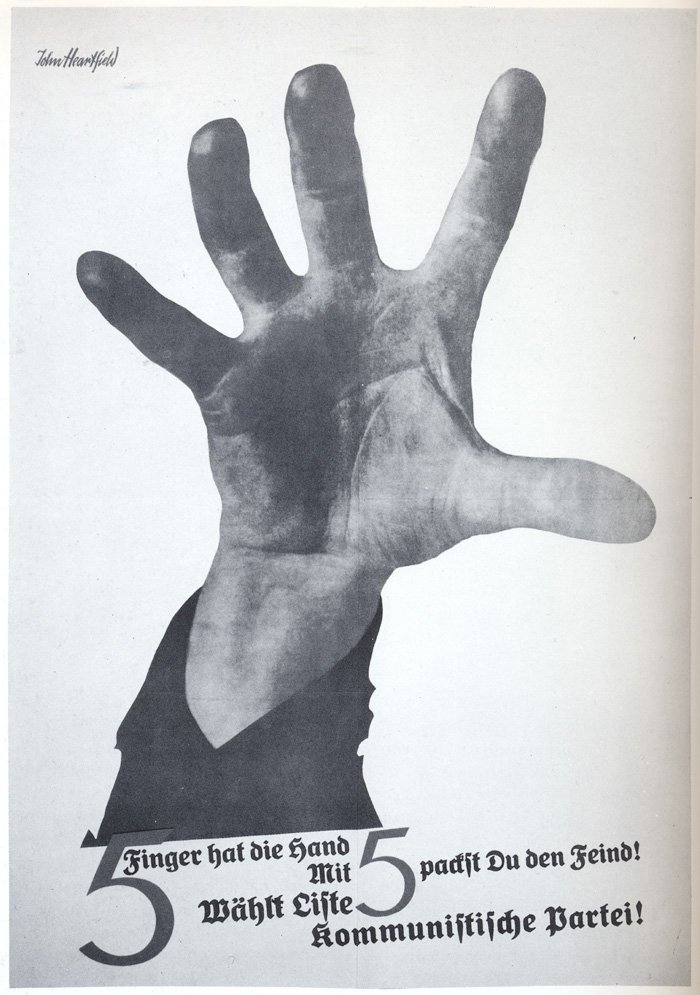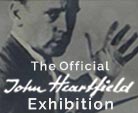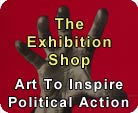Heartfield Poster Open Hand Image. Five Fingers Has The Hand (5 Finger Hat Die Hand). A Simple Photo. A Powerful Political Symbol.
Famous Political Art Antiwar Masterpieces
5 Finger hat die Hand(5 Fingers Has The Hand)

5 Fingers Has The Hand


John Heartfield Poster Open Hand Reminder: Voting Matters!
By Andrea Hofmann and John J Heartfield
The left-wing KPD was popular among workers because it promoted labor unions, social welfare programs and progressive taxation. It stood in strong opposition to anti-Semitism and racism. The party had a powerful feminist agenda, supporting equality and better economic conditions and opportunities for women. It was the only German political party of that era that had prominent woman leaders, such as Clara Zetkin. It is notable that the KPD had the most women candidates for office.
Heartfield’s 5 Fingers Has the Hand has had many incarnations throughout history. The hand was a 1928 German election poster. A newspaper featured it on its front page. It appeared on album covers for popular bands such as System Of A Down. The hand became an exhibition poster and appeared as a tattoo on the Internet.
The Tale Of The Art
John Heartfield usually worked on assignment. But would have had a clear vision of what he wanted. His nimble visual mind would come up with several ideas for consideration. However, his process for this piece was much different. The five fingers of a hand reaching out to grab voters’ attention was a vision so powerful, Heartfield jumped up and rushed off the moment the image took shape in his mind.
Heartfield’s son, Tom, described how his father stood outside a factory and encouraged exiting workers to hold up their hand as a photographer shot photo after photo of workers’ hands. Heartfield studied all the photographs and chose the most powerful image: the smudged hand of a worker reaching for something.
Techniques To Remember The “Number 5”
John Heartfield’s goal was to make potential voters remember the KPD vote ticket “Number 5.” And, he knew the techniques to accomplish that. He had trained in advertising design and studied with Ernst Neumann, one of Germany’s leading advertising designers. Neumann held Germany’s only chair for advertising design.
Heartfield applied a key strategy of advertising: repetition. He repeats the number “5” three times in the piece, twice as a number and once as a body part. Making the number a part of the human body made it personal. This technique targeted a voter’s subconscious. It helped them remember the party’s ballot position.
Our hands are important to us and we assign a great deal of meaning to them. Using them is part of our body language. Because hands are so expressive, we learn to read gestures and hand expressions very early.
The John Heartfield Poster Open Hand Image
What we see in Heartfield’s montage is an open worker’s hand about to grip something. We reach for something when we want it. There is also a German proverb, “Take matters into your own hands.” The hand encouraged voters to take action, vote for the KPD, seize the enemy, and make things happen!
The Hand Remains A Warning
The KPD was 4th in the 1928 Reichstag election. It polled over 3 million votes and won 54 seats. This amounted to 10.6% of the vote. Hitler’s Nazi party only won twelve seats. However, power relations can change quickly. Only five years later, in 1933, voters gave the Nazis 43.9% in the election where Nazi propaganda blamed their political opposition for the Reichstag fire. By joining with a minor party (there was no shortage of political parties in Germany), Hitler took control of the government. Hitler’s political party was not named the “Nazi Party.” His followers did not not call themselves “Nazis.” The name of Adolf Hitler’s political party was the National Socialist German Workers Party. The term “German Workers” is usually dropped when referring to the Third Reich’s political party. However, Hitler rose to power by promising a better economy and an end to widespread unemployment after a humiliating WWI peace agreement imposed crippling fines and economic hardship on Germany. Such conditions likely contributed to an acceptance of Hitler’s simple slogans “Only I Can Fix It!” and “Make Germany Great Again!” However, as history often shows, when a strongman takes the reins, a regime of terror and war follows.
The John Heartfield poster open hand image is a timeless warning to act while we still can. Every vote counts. Never waste that opportunity.
Heartfield Poster Open Hand Image
Appeared: May 13, 1928
Berlin, Germany
Share Your Reaction To This Art
Heartfield Poster Open Hand
One Vote Can Change Everything
By John J Heartfield
Adolf Hitler did not march into Berlin in 1933 leading a Nazi army. Paul von Hindenburg, the second president of the Weimar Republic, offered Hitler the chancellorship of Germany in a disintegrating political climate. The Nazi Party received only 43.9 percent of the vote needed to control Germany’s Parliament. However, by joining with another of Germany’s many political parties, Hitler achieved a majority. In March 1933, he took absolute power with the Enabling Act. He outlawed all other political parties, organizations, and people not aligned with Nazi philosophy.
This famous political symbol is an image for a political poster John Heartfield created for the 1928 German election. The goal was to remind voters to vote for the KPD (German Communist Party), vote ticket number 5. John Heartfield was not a typical party member. He was too independent minded. He often clashed with the “group think” of a communist system. Yet his anti-Nazi anti-fascist political art was a clear threat to the Nazi propaganda machine. He lived a public life in Berlin. His art made him a marked man. He paid a heavy physical price.
Text on the poster translates to: “5 Fingers Has the Hand! With 5 You Seize The Enemy!” The enemy was the Nazi Party. The KPD party had a good chance to defeat Hitler. However, Nazi propaganda was strong. It relied on German nationalism and economic hardship. Before the 1933 election, the Nazis smeared, brutalized, and arrested their political opponents.
This image continues to inspire resistance. It appeared on a System of a Down album: “The hand has five fingers, capable and powerful, with the ability to destroy as well as create.”
One hand has the power to cast a vote that can prevent a dictatorship. In 1928, the KPD (German Communist Party) was Germany’s best hope to halt the political rise of Adolf Hitler and The Nazis.
Many of Berlin’s most creative and talented artists also joined the communist party in the first half of the twentieth century. The same was true in the United States. Later, those American artists suffered because of the shameful Joe McCarthy hearings. John Heartfield also suffered when, after the war, countries rejected his pleas to remain in a democracy. He had to return to the repressive communist government of East Germany where he narrowly avoided a treason trial.
However, in 1928 Germany, between the KPD and The Nazis, communists were the lesser of two evils. Elections that determined German history took place between 1928 and 1933. Every vote counted.
Heartfield understood there was nothing more powerful than the human hand when five fingers worked together. The hand was a perfect symbol to oppose Hitler (or any dictator).
John Heartfield waited outside a factory. He had his photographer take photo after photo of workers’ hands. The perfect hand became a part of anti-fascist history.

